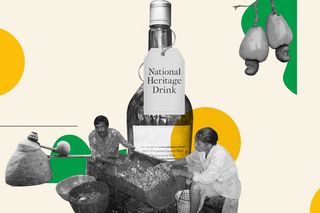
Companies are Rebranding Indigenous Liquors Like Mahua Into Desi Cocktails. Who Stands To Gain?
A growing urban market for these national beverages spells trouble for local producers and their communities.

On a trip to Kerala’s Idduki district, a 26-year-old Ashwathy finds herself sitting in a small but clean shop, one among many flanked on each side of the road. She had come to try the fabled toddy, or palm wine — an alcoholic beverage brewed locally. The shop, she remembers, was run by a man from the Adivasi community who brewed his own toddy. Transparent glass bottles, with no label or distinct marks, come with milky coconut alcohol, filled to the rim.
“Unlike spirits, [toddy] takes a really long time to get you high,” she jokes, recalling her tryst with this indigenous alcohol. The brew was unconventional, the experience even more so.
Indigenous or country alcohol — like mahua, feni, or toddy — is consumed primarily by those who live and care for the habitat where the raw materials are grown. These local spirits are often shared with visitors by the producers directly, when fascinated travellers come in search of alcohol brewing inside little huts, homes of their Adivasi friends, or in thekas run by members of tribal communities. Described as small and minimal, or even ‘shady,’ these unfamiliar environments feature as vividly in anecdotes, as the alcohol itself.
But this rarity seems to be waning with time. A shift over the last decade has opened up routes for the commercialization of indigenous liquor. At its root, country liquor is unrectified spirit and is distinct against other licensed and branded Indian-Made Foreign Liquor (IMFL), like Bira 91 or Old Monk rum. But now, a growing section of consumers can attest to drinking toddy — served in bulky glass tumblers — in expensive urban pubs like Hard Rock Café, or eating delicacies cooked up with feni in Goan restaurants. Bedbyas, a young professional, says hot toddy, an unconventional but popular tonic, was recommended to him at Hard Rock as a cure for his cold.
The growing popularity, however, separates the spirits from their habitats — making the forest and the producers living in its shadow vulnerable to sweeping commodification.
Related on The Swaddle:
Amid Covid19 Alcohol Ban, Sri Lankans Are Brewing Moonshine
Let’s take the case of mahua. The mahua flowers used to make liquor are intricately woven into the cultural practices of Adivasi communities in various states. The flowers are handpicked and sold to non-Adivasi traders for revenue. Sometimes, they have to be bought back at fluctuating and exorbitant values to brew liquor during festivals or leisure, to barter with, to use as cattle-feed or as food, or to offer to ancestral spirits. The flower is an important lifeline for these communities, its sale sustaining quotidian livelihoods.
The sale of mahua is further governed by excise laws across states, which do not allow the Adivasi community to sell the liquor they produce. This ban can be attributed to many things: a need to increase the popularity of IMFL, inconsistent stances about prohibition and substance abuse, a political crackdown on land, even systemic discrimination. People in the community are allowed no more than 5 litres for personal consumption. These bans are enforced sternly, with raids and incarceration on grounds of possession of mahua becoming increasingly common. Even anti-alcohol campaigns have been deployed in the last few years to rile up communal Hindutva dissent among tribes.
Against this landscape, Indian entrepreneurs like Desmondji and Native Brews have been making attempts to procure, distill, and bottle mahua for a new urban middle- and upper-class clientele. Susan Dias, founder of Native Brews, says she didn’t have to go looking for a story when it came to mahua. Mahua is rare, though it has a deep cultural history, and it’s the only spirit that is produced from a flower. In the course of her two-year-long research into India’s traditional alcohol beverages, she came across the following findings: we have recipes handed down from grandmothers, and we possess a sense of pride in our food and wine culture. The emphasis seems to be that in our multicultural world, there is direct and unmediated access to all ways of life.
Desmond Nazareth of Desmondji, a maker of craft spirits, would agree with this ideology. His reproductions of mahua promise to retain the traditional flavour — so much so that he sees in mahua potential to be a “national alcoholic beverage.” State-run initiatives like Mahua Nutribeverage that boast of high nutrition are not far behind, and a ‘desi beer’ is likely to be on the shelves of supermarkets soon.
These new brands are quick to claim the indigenous identity of these alcoholic drinks for a burgeoning class of consumers: liberal, environmentally conscious, and more likely to buy a product with a made-in-India label. For these businesses, it is crucial to brand these local spirits such that they resonate with the new consumer aspirations. Debanjan, a young designer who has worked with many sustainable brands catering to a younger crowd, remarks on the liberal use of the serif font and the minimalism of these new brands. He points towards an affected datedness to showcase the brand and mimic local authenticity. Consumers interviewed for this article say they feel brand success lies in leveraging the Adivasi backstory.
As cultural anthropologist Meher Verma and designer Pia Hazarika note, brands today attempt to be simultaneously global and Indian. The website for Desmondji compares mahua to the Mexican agave/tequila, forcing the association to internationally recognised competence. The bottles are dressed in Madhubani-type art with a coriander-green hue. “Contemporary food brands that speak the language of digital gastronomy now make India appear exotic to Indians,” Verma and Hazarika add. In the age of Instagram, cultural negotiation itself appears to be fetishized.
The effect is such: the ‘local’ brew is reinvented into homogenous brands that citizens can call their own, albeit if their pockets allow. This commercialization handpicks products from indigenous cultures — boasting of varying practices and recipes.
Arunopol Seal, a scholar at the University of Helsinki, chalks up this cultural commodification up to “fundamental appropriation” — the process of taking mahua and its production away from “nature, which is a part of the community,” to fit it into the scheme of modernity.
But he refuses to write off this capitalist hegemony as inevitable, affirming the existence of other markets — Adivasi markets in particular — where the community and environment are non-alienated and agentive, capable of determining a relationship to the forest that is beyond its value as a product, or at least in keeping alive their own markets. Tree tappers’ associations in Karnataka have been packaging and selling sap for years, he notes as an example, which effectively gives “IMFL a run for their money”.
‘Instagram-worthy’ marketing and international acclaim have, however, created a substantial buzz around these upcoming products. Consumer interest is also fuelled by the idea of uplifting and empowering local communities by allowing mahua to be sold. The urban entrepreneurs themselves appear to be socially conscious and savvy, noting that they’re enhancing livelihoods and environments while also adhering to international standards of hygiene. These brands claim better working conditions and environmentally sustainable practices, like using solar-powered energy and committing to proper waste management practices. Nazareth himself hopes to empower a billion kids.
But this growing market interest is likely to have ecological implications. Considerations such as setting up more cold storage facilities will demand more land use. Moreover, it is unlikely that many from the community will be able to produce and determine the way in which these liquors are sold/consumed. The mahua flowers, for instance, only grow for a few summer months. How they are grown, collected, and used is not only environmentally conscious but also vital to crafting an engaged and unalienated relationship between the community and the forest.
Related on The Swaddle:
People Believe Different Types of Alcohol Give Them Different Moods, Highs. It’s a Myth.
The entrepreneurs claim that Indians’ relationship with alcohol is evolving, departing from traditional notions about liquor being a Western malaise. If numbers are anything to go by, significant revenue continues to be dependent on this economy. There is also interest in exporting to international markets like the U.S. and Europe. Therefore, it only makes sense for urban sellers to increasingly bring indigenous liquors into the IMFL fold.
“I had to convince the Andhra Pradesh government to permit mahuato be also considered as an IMFL,” Desmond Nazareth noted in a report, hinting at the elaborate red tape. Nazareth was granted permission after much effort to manufacture mahua as a non-country spirit. Other sources confirm that changes in excise law regarding mahua are imminent this year to capitalise on this dynamic.
Even as potential large-scale sellers are paving the way to commercialise the sale of these liquors, Adivasi producers continue to be subjected to brutal whims of non-Adivasi traders, police, and government outfits. Their culture has been deemed fit for export, but their lives continue to weigh the same. Whether these changes will spell any benefits for the local brewers is for the future to determine — but if the Farm Bills are anything to go by, it is likely that private parties might call all the shots.
The distilling and distribution of indigenous alcohol, or the proud ‘forest-to-bottle’ movement, is only bringing in yet another product to clamour for relevance in the market. And as it packages, brands, and commodifies the forest and its inhabitants, it tacitly alters the relationship consumers share with the idea of community, their neighbours, and the nation.
Everything can be made in India, the new dynamic whispers, and everyone is for sale.
Shinjini Dey is a freelance editor and writer. Find her on Twitter at @shinjini_dey.
Related


Apps Like Uber, Ola Make Driving a Flexible Profession. Why Can’t More Women Tap Into It?
